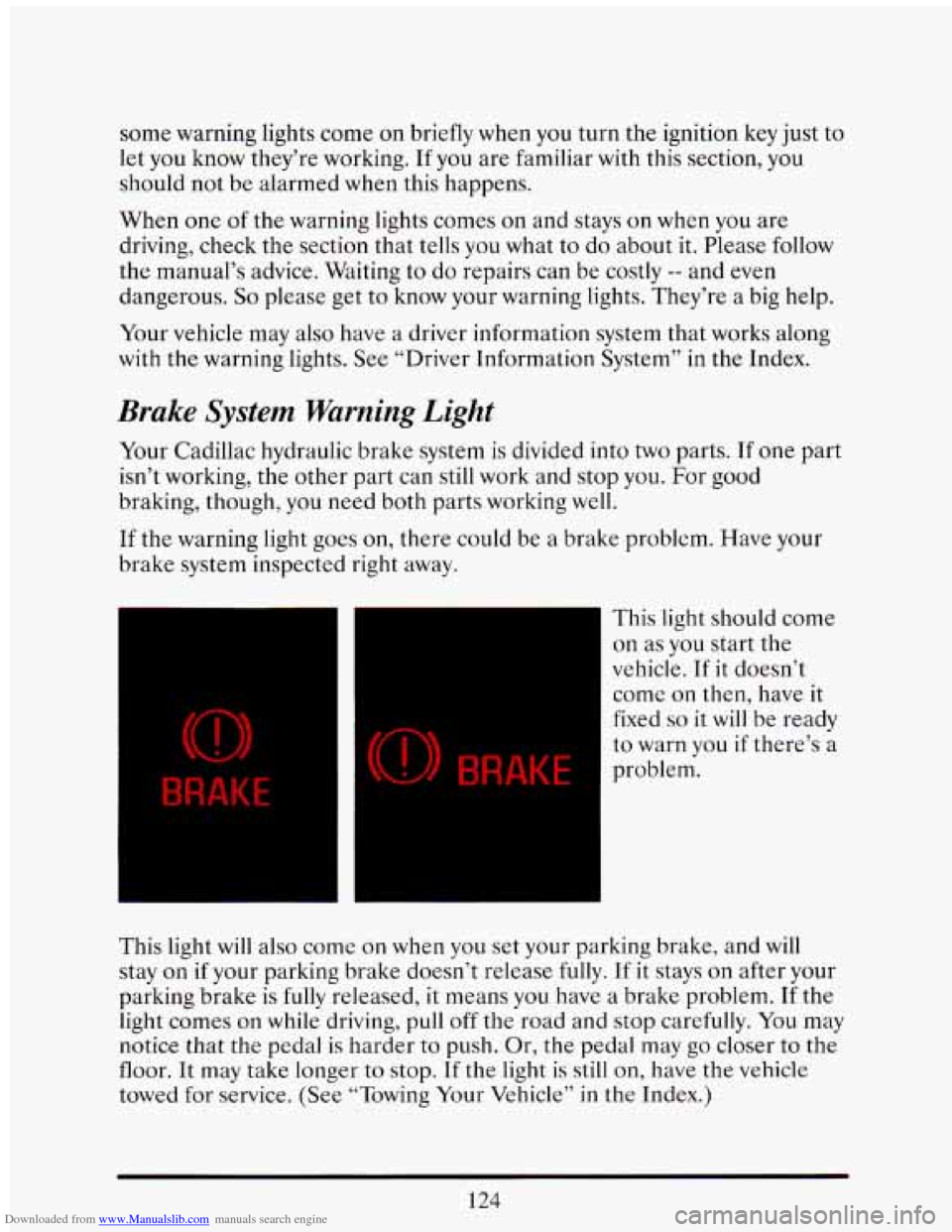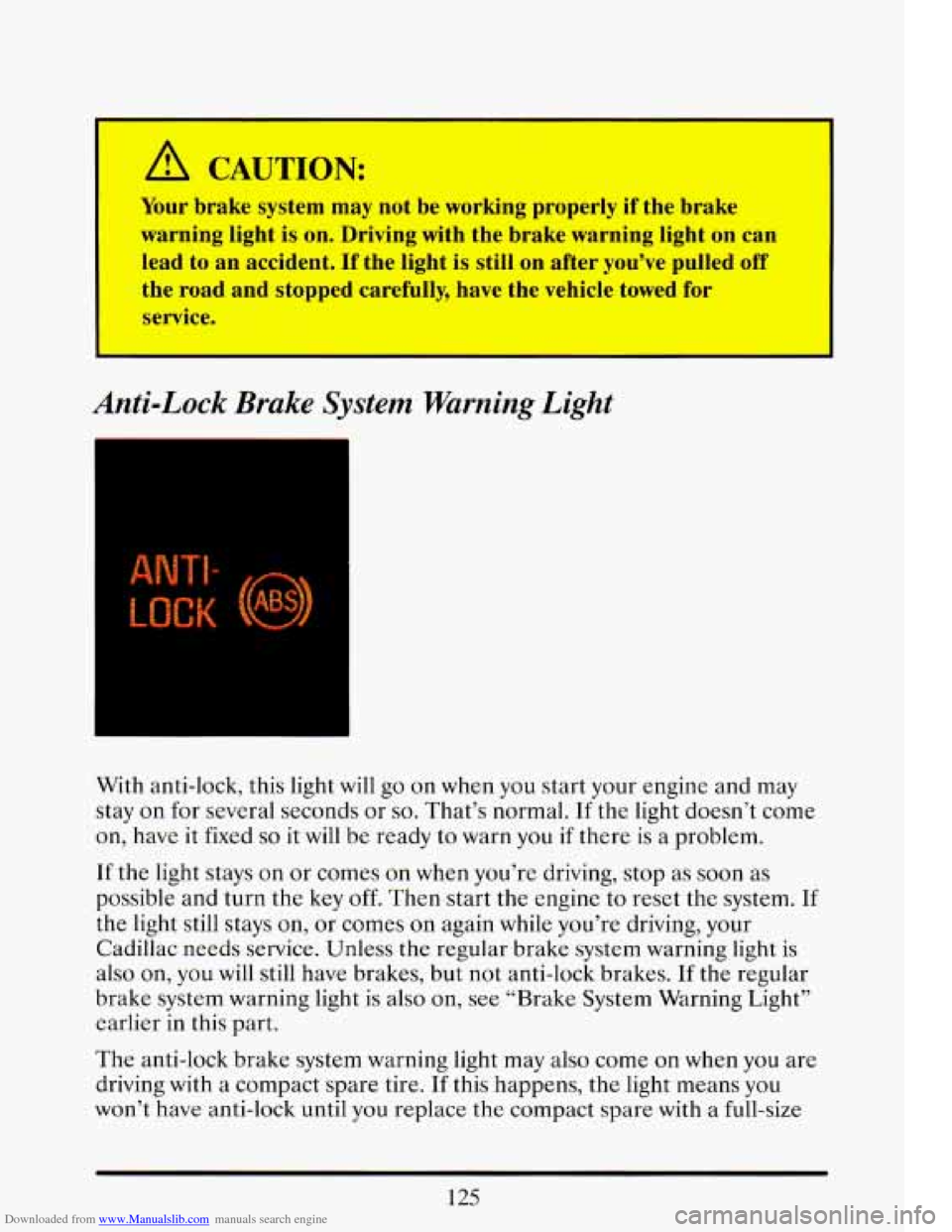1993 CADILLAC ELDORADO brake light
[x] Cancel search: brake lightPage 19 of 398

Downloaded from www.Manualslib.com manuals search engine These symbols are used on warning and indicator lights:
I- I
I
ENGINE COOLANT
TEMPERATURE I
/u/L
BATTERY
CHARGING SYSTEM
u
BRAKE
ENGINE
OIL PRESSURE ENGINE OIL TEMPERATURE
Here are some other
symbols you may see:
A
TRUNK HATCHBACK
RELEASE
U
RADIO SELECTOR
t
l=I
I LIGHTER RADIO VOLUME
1
I HORN 1
RADIATOR
COOLANT
ANTILOCK BRAKE
AIR
CONDITIONING
I
-
SPEAKER
5
Page 99 of 398

Downloaded from www.Manualslib.com manuals search engine To set the parking brake:
Hold the regular brake pedal down with your right foot. Push down the
parking brake pedal with your left foot. If the ignition
is on, the brake
system warnin? light
will come on.
I-
I
When you move out
of “P” (Park) or “N”
(Neutral), if your
engine
is running,
your parking brake should go off.
If it
doesn’t, you have a
parking brake
problem and should have it fixed.
In the
meantime,
you can
still release your
parking brake. Just
pull on the manual
release lever, as
shown.
I
3me-q 5::- &*ZL !My& se-4
A CAUTION: . -- .
If your hand or arm is in the way of thi’pedal, you could be -,::+ -+..:
hurt. The pedal springs back quickly. Keep your hand and arm !+. ,--,:“:
away when you use 1 ! manual release lever. :,F
.L- ..
-.7 7 .--.. , - ., .I .. - .>, _. .- : - .?f I - - .. - --. . ’-: .:. ..:= . ’. + .? .. .
NOTICE
Driving with the parking lake on can cause ~UL- rear bra,
overheat.
You mav have to replace them- and vou could also
,.*age ~ ~. .: . ~ i nther pal vnur vfihicle.
L .~-:’? . - I . - . i i .. ~
85
Page 119 of 398

Downloaded from www.Manualslib.com manuals search engine To Get Out of Cruise Control
There are two ways to turn off the Cruise Control:
1. Step lightly on the brake pedal ; OR
I - P
2. Move the CRUISE switch to “OFF” (The “CRUISE” light will go
out .)
105
Page 138 of 398

Downloaded from www.Manualslib.com manuals search engine some warning lights come on briefly when you turn the ignition key just to
let you know they’re working.
If you are familiar with this section, you
should not be alarmed when this happens.
When one
of the warning lights comes on and stays on when you are
driving, check the section that tells you what to do about it. Please follow
the manual’s advice. Waiting to do repairs can be costly
-- and even
dangerous.
So please get to know your warning lights. They’re a big help.
Your vehicle may
also have a driver information system that works along
with the warning lights. See “Driver Information System” in the Index.
Brake System Warning Light
Your Cadillac hydraulic brake system is divided into two parts. If one part
isn’t working, the other part can still work and stop you. For good
braking, though, you need both parts working
well.
If the warning light goes on, there could be a brake problem. Have your
brake system inspected right away.
BRAKE
(0) BRAKE
This light should come
on as you start the
vehicle. If it doesn’t
come
on then, have it
fixed
so it will be ready
to warn you if there’s a
problem.
This light will also come
on when you set your parking brake, and will
stay
on if your parking brake doesn’t release fully. If it stays on after your
parking brake
is fully released, it means you have a brake problem. If the
light comes
on while driving, pull off the road and stop carefully. You may
notice that the pedal is harder
to push. Or, the pedal may go closer to the
floor. It may take longer to stop.
If the light is still on, have the vehicle
towed for service. (See “Towing Your Vehicle” in
the Index.)
124
Page 139 of 398

Downloaded from www.Manualslib.com manuals search engine I
A CAUTION:
Your brake system may not be working properly if the brake
warning light is
on. Driving with the brake warning light on can
lead to an accident. If the light is still
on after you've pulled off
service. e road and
stopped carefully, have the vehicle towed for
I
Anti-Lock Brake System Warning Light
=
With anti-lock, this light will go on when you start your engine and may
stay
on for several seconds or so. That's normal. If the light doesn't come
on, have it fixed
so it will be ready to warn you if there is a problem.
If the light stays on or comes on when you're driving, stop as soon
as
possible and turn the key off. Then start the engine to reset the system. If
the light still stays on, or comes on again while you're driving, your
Cadillac needs service. -Unless the regular brake system warning light is
also on,
you will still have brakes, but not anti-lock brakes. If the regular
brake system warning light is also on, see "Brake System Warning Light"
earlier in this part.
The anti-lock brake system warning light may also come
on when you are
driving with a compact spare tire.
If this happens, the light means you
won't have anti-lock until you replace the compact spare with a full-size
125
Page 149 of 398

Downloaded from www.Manualslib.com manuals search engine CHANGE TRANS FLUID (Northstar Only)
This message will appear when it is time to replace the transaxle fluid.
See your maintenance booklet for the proper fluid and change i\
ntervals.
CHECK BRAKE FLUID
This message is displayed to inform the driver that the brake reservoir
fluid level
is low. Check the brake reservoir level and add as needed.
Have the brake system serviced by
a Cadillac technician as soon as
possible.
If the brake warning light is on, follow the directions in that
section.
CHECK COOLANT LEVEL (Northstar Only)
This message will appear when there is a low level of engine coolant.
Have the cooling system serviced by a Cadillac technician as soon as
possible.
CHECK FUEL GAGE
This message will appear when your fuel supply is less than 4 gallons and
your display is turned
off.
CHECK OIL LEVEL (Northstar Only)
This message will appear when your engine oil is approximately a quart
low. If this message is displayed, check the oil and add as needed.
CHANGE OIL SOON
This message will appear when your engine oil is less than 10 percent or
the mileage since the last oil change is more than 6750 miles.
CHANGE ENGINE OIL
135
This means that the life of your engine oil has expired and it should be
changed immediately. See engine
oil and filter recommendations in the
Maintenance Schedule. After an
oil change, the Oil Life Index must be
reset. See “Oil Life Indicator”
in the index on how to reset it.
Page 185 of 398

Downloaded from www.Manualslib.com manuals search engine Many city roads and expressways, and even bridges, use reversible-lane
traffic control during rush hours. A red
X light above a lane means no
driving in that lane at that time.
A green arrow means you may drive in
that lane.
Look for the signs posted to warn drivers what hours and days
these systems are in effect.
PAWMENT MmNGS
I NU
PASSING
ZONE
Pavement markings add to traffic signs and signals. They give information
to drivers without taking attention from the roadway. A solid yellow line
on your side of the road or lane means “don’t cross.’’
YOUR OW SIGNALS
Drivers signal to others, too. It’s not only more polite, it’s safer to let
other drivers know what you are doing. And in some places the law
requires driver signals.
Turn and lane change signals. Always signal when
you plan to turn or
change lanes.
If necessary, you can use hand signals out the window: Left arm straight
out for a left turn, down for slow
or about-to-stop, and up for a right turn.
Slowing down.
If time allows, tap the brake pedal once or twice in
advance
of slowing or stopping. This warns the driver behind you.
Disabled. Your four-way flashers signal that your vehicle is disabled or is
a hazard.
See “Hazard Warning Flasher” in the Index.
171
Page 186 of 398

Downloaded from www.Manualslib.com manuals search engine TRAFFIC OFFICER
The traffic police officer is also a source of important information. The
officer’s signals govern, no matter what the traffic lights
or other signs
say.
The next section discusses some
of the road conditions you may
encounter.
DEFENSIVE DMNG
The best advice anyone can give about driving is: Drive defensively.
Please start with a
very important safety device in your Cadillac: Buckle
up. (See “Safety Belts” in the Index.)
Defensive driving really means “be ready for anything.” On city streets,
rural roads, or freeways, it means “always expect the unexpected.”
Assume that pedestrians or other drivers are going to be careless and
make mistakes. Anticipate what they might do. Be ready for their
mistakes.
Expect children to dash out from behind parked cars, often followed by
other children. Expect occupants in parked cars to open doors into traffic.
Watch for movement in parked cars
-- someone may be about to open a
door.
Expect other drivers to run stop signs when you are
on a through street.
Be ready to brake if necessary as
you go through intersections. You may
not have to use the brake, but if
you do, you will be ready.
If you’re driving through a shopping center parking lot where there are
well-marked lanes, directional arrows, and designated parking are\
as,
expect some drivers to ignore all these markings and dash straight toward
one part
of the lot.
Pedestrians can be careless. Watch for them. In general, you must give
way
to pedestrians even if you know you have the right of way.
Rear-end collisions are about the most preventable of accidents. Yet they
are common. Allow enough following distance. It’s the best defensive
driving maneuver,
in both city and rural driving. You never know wh.en
the vehicle in front
of you is going to brake or turn suddenly.
172